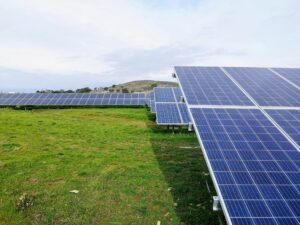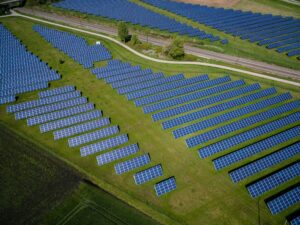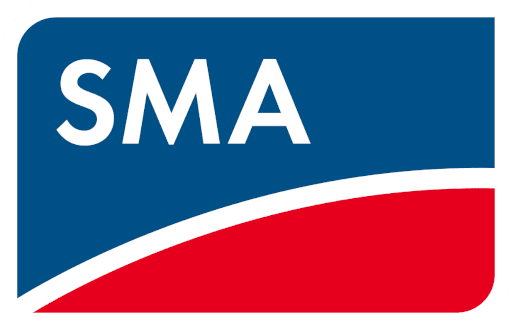Solar-generated electricity pollutes neither air nor water. Solar energy does also not result in emission of dangerous carbon dioxide, which causes adverse climate change, except during the
making of the solar panels. A solar panel’s land use impact is practically nonexistent since they are placed on roofs. Additionally, solar power creates more jobs per unit of energy than energy generated using fossil fuels, and the these jobs cannot be outsourced since construction of such power systems is done locally. The use of solar energy also results in consumption of less water than say, coal, natural gas, and nuclear energy, which means it does not put a strain on community resources.
But, as great as solar energy may sound, there is a major obstacle to its widespread uptake – cost. A
solar energy system can cost over $10,000 a unit, something just a few lucky Americans can manage to pay, even through borrowing.

Here is where the fund created by SolarCity and Google might help. Of the $700 million SolarCity-Google fund, Google has provided $300 million. The fund is aimed at helping people overcome the prohibitive upfront costs of setting up solar power systems, something that should boost rooftop solar accessibility for lower-middle and upper-middle classes.
SolarCity’s VP, Jonathan Bass, has termed the project as a democratization of access to solar energy.
Nevertheless, this type of deal is not the first of its kind. There have been solar leases and power purchase agreements, which are slightly different to what SolarCity and Google are offering. However, they also try to solve the problem of the prohibitive upfront costs that are reducing access to solar power. Under these earlier deals, the customer only has to handle the monthly power costs, with the option to purchase the system later if they so desire.
The SolarCity and Google fund will offer these aspects, but with a twist. Essentially, the two partners seek to subvert the notion that green energy is more costly than traditional energy. So, in addition to the fund distribution being affected by things like sunlight exposure, it will also take into consideration local cost of retail electricity, which varies from place to place.
SolarCity does not have the ability to make the ubiquitously available, although they are operating in 14 states and estimate that they can get to 25,000 new households and add new energy capacity of 500 MW. This will be a big boost to the 190,000 customers and 1,000 MW the company had achieved at the close of 2014.
According to the VP, the appeal for users of solar energy under SolarCity’s deal comes from the homeowners being able to pay less for solar energy than they did for traditional power while at the same time avoiding the crippling upfront costs. Essentially, these are customers who are happy to save about $20 to $40 a month, which can add up to thousands of dollars over time.
A similar project by California Solar Initiative, launched in 2007, boosted the uptake of rooftop solar for homeowners by up to over 400%.
Unfortunately, there is a limit as to how far down the income ladder these solar deals can extend without compromising on ethics and sustainability. This is considering that predatory lenders and rent-to-own furniture businesses have in the past enticed the poor into entering into ill-advised deals that ultimately caused them financial turmoil.
Although this is one area where this kind of deal can go sour, so far, the Google-SolarCity partnership is doing great. The two have even managed to lower the prerequisite credit score to just 650, though its not clear if they can go any lower.
Mr. Bass says that defaults are extremely rare, possibly because giving someone a chance to spend less on energy does not create the motivation to make payment defaults, since this would mean having to pay more for regular power.
Furthermore, at lower income levels, most people rent apartments and homes rather than buying them. This means that SolarCity has to deal with the building owner, which is an entirely different ballgame. Therefore, the deals are affected to a large degree by homeownership.
Granted, these kinds of deals help improve access of essential goods and services to lower income Americans. But, they can only do so much. Ultimately, there can be no substitute to policy change if access is to be improved for everyone. Policy helps empower everybody, especially at the lower income levels, where the increase in purchasing power is most needed.
The truth of this fact is undeniable, regardless of whether you purpose to help everyone achieve their “American dream” as pertains to home ownership, or make green energy the prime mover for the entire economy, and so so forth.
 There are about 37.5 million miles (60 million kilometers) of roads in the world that are used for nothing other than road transport. However, adapting these expensive surfaces for other things such as to harness solar energy has proven to be quite expensive and difficult. Some of the past attempts include converting vibrations on busy roadways into electricity. However, this unique innovation is only economically viable on some of the busiest roads which account for a very small fraction of the world’s vast road network.
Another technology captures and stores the heat energy on roads during summer and supply it trough roads during the cold weather in order to keep roads free from ice. Japan has even established a working test patch of this technology in Hiroshima.
The unique idea that has gained massive popularity and traction in the recent past is embedding solar cells on the roads. The Solar Roadways project was launched by an American couple in 2014 and it managed to collect more than $2 million on Indiegogo which is a crowdfunding site.
However, the Consortium SolaRoad which is based in Netherlands is closer to reality because it has been operating a 230 foot (70 meter) cycle path that can generate enough electricity for at least two households. This unique system was up and running by November 2014 and the field testing results over a period of six months are positive. The project has actually been generating more electricity than had been predicted in the SolaRoad laboratories.
How does this principle work?
The system uses photovoltaic cells are supported by concrete and rubber at the bottom and protected by strong glass on the top. Besides letting light through, the glass has properties that are similar to concrete or asphalt; it is glare free, skid resistant and very durable. These units are connected to a central system that generates electricity and feeds it to the grid. SolaRoad claims that even a 12 ton truck could ride safely over the road. However, the company has only tested 150,000 cycles so far. Although the road has some minor chippings, the project has continued to work smoothly without any major shortcomings. Therefore, the next step is to use the system in highways or more roads in local councils.
The economic case for SolaRoad’s business is the main reason why it stands out from competitors. The four companies that are involved in the consortium project complement each other very well.
There are about 37.5 million miles (60 million kilometers) of roads in the world that are used for nothing other than road transport. However, adapting these expensive surfaces for other things such as to harness solar energy has proven to be quite expensive and difficult. Some of the past attempts include converting vibrations on busy roadways into electricity. However, this unique innovation is only economically viable on some of the busiest roads which account for a very small fraction of the world’s vast road network.
Another technology captures and stores the heat energy on roads during summer and supply it trough roads during the cold weather in order to keep roads free from ice. Japan has even established a working test patch of this technology in Hiroshima.
The unique idea that has gained massive popularity and traction in the recent past is embedding solar cells on the roads. The Solar Roadways project was launched by an American couple in 2014 and it managed to collect more than $2 million on Indiegogo which is a crowdfunding site.
However, the Consortium SolaRoad which is based in Netherlands is closer to reality because it has been operating a 230 foot (70 meter) cycle path that can generate enough electricity for at least two households. This unique system was up and running by November 2014 and the field testing results over a period of six months are positive. The project has actually been generating more electricity than had been predicted in the SolaRoad laboratories.
How does this principle work?
The system uses photovoltaic cells are supported by concrete and rubber at the bottom and protected by strong glass on the top. Besides letting light through, the glass has properties that are similar to concrete or asphalt; it is glare free, skid resistant and very durable. These units are connected to a central system that generates electricity and feeds it to the grid. SolaRoad claims that even a 12 ton truck could ride safely over the road. However, the company has only tested 150,000 cycles so far. Although the road has some minor chippings, the project has continued to work smoothly without any major shortcomings. Therefore, the next step is to use the system in highways or more roads in local councils.
The economic case for SolaRoad’s business is the main reason why it stands out from competitors. The four companies that are involved in the consortium project complement each other very well.

 The steady increase in the level of energy prices the last few decades has ignited the search for cheap and reliable sources for home and business owners. There is no better approach to this than renewable or “green” power system as most people would like to call it.
The steady increase in the level of energy prices the last few decades has ignited the search for cheap and reliable sources for home and business owners. There is no better approach to this than renewable or “green” power system as most people would like to call it.  Here is where the fund created by SolarCity and Google might help. Of the $700 million SolarCity-Google fund, Google has provided $300 million. The fund is aimed at helping people overcome the prohibitive upfront costs of setting up solar power systems, something that should boost rooftop solar accessibility for lower-middle and upper-middle classes.
SolarCity’s VP, Jonathan Bass, has termed the project as a democratization of access to solar energy.
Nevertheless, this type of deal is not the first of its kind. There have been solar leases and power purchase agreements, which are slightly different to what SolarCity and Google are offering. However, they also try to solve the problem of the prohibitive upfront costs that are reducing access to solar power. Under these earlier deals, the customer only has to handle the monthly power costs, with the option to purchase the system later if they so desire.
The SolarCity and Google fund will offer these aspects, but with a twist. Essentially, the two partners seek to subvert the notion that green energy is more costly than traditional energy. So, in addition to the fund distribution being affected by things like sunlight exposure, it will also take into consideration local cost of retail electricity, which varies from place to place.
SolarCity does not have the ability to make the ubiquitously available, although they are operating in 14 states and estimate that they can get to 25,000 new households and add new energy capacity of 500 MW. This will be a big boost to the 190,000 customers and 1,000 MW the company had achieved at the close of 2014.
According to the VP, the appeal for users of solar energy under SolarCity’s deal comes from the homeowners being able to pay less for solar energy than they did for traditional power while at the same time avoiding the crippling upfront costs. Essentially, these are customers who are happy to save about $20 to $40 a month, which can add up to thousands of dollars over time.
A similar project by California Solar Initiative, launched in 2007, boosted the uptake of rooftop solar for homeowners by up to over 400%.
Unfortunately, there is a limit as to how far down the income ladder these solar deals can extend without compromising on ethics and sustainability. This is considering that predatory lenders and rent-to-own furniture businesses have in the past enticed the poor into entering into ill-advised deals that ultimately caused them financial turmoil.
Although this is one area where this kind of deal can go sour, so far, the Google-SolarCity partnership is doing great. The two have even managed to lower the prerequisite credit score to just 650, though its not clear if they can go any lower.
Mr. Bass says that defaults are extremely rare, possibly because giving someone a chance to spend less on energy does not create the motivation to make payment defaults, since this would mean having to pay more for regular power.
Furthermore, at lower income levels, most people rent apartments and homes rather than buying them. This means that SolarCity has to deal with the building owner, which is an entirely different ballgame. Therefore, the deals are affected to a large degree by homeownership.
Granted, these kinds of deals help improve access of essential goods and services to lower income Americans. But, they can only do so much. Ultimately, there can be no substitute to policy change if access is to be improved for everyone. Policy helps empower everybody, especially at the lower income levels, where the increase in purchasing power is most needed.
The truth of this fact is undeniable, regardless of whether you purpose to help everyone achieve their “American dream” as pertains to home ownership, or make green energy the prime mover for the entire economy, and so so forth.
Here is where the fund created by SolarCity and Google might help. Of the $700 million SolarCity-Google fund, Google has provided $300 million. The fund is aimed at helping people overcome the prohibitive upfront costs of setting up solar power systems, something that should boost rooftop solar accessibility for lower-middle and upper-middle classes.
SolarCity’s VP, Jonathan Bass, has termed the project as a democratization of access to solar energy.
Nevertheless, this type of deal is not the first of its kind. There have been solar leases and power purchase agreements, which are slightly different to what SolarCity and Google are offering. However, they also try to solve the problem of the prohibitive upfront costs that are reducing access to solar power. Under these earlier deals, the customer only has to handle the monthly power costs, with the option to purchase the system later if they so desire.
The SolarCity and Google fund will offer these aspects, but with a twist. Essentially, the two partners seek to subvert the notion that green energy is more costly than traditional energy. So, in addition to the fund distribution being affected by things like sunlight exposure, it will also take into consideration local cost of retail electricity, which varies from place to place.
SolarCity does not have the ability to make the ubiquitously available, although they are operating in 14 states and estimate that they can get to 25,000 new households and add new energy capacity of 500 MW. This will be a big boost to the 190,000 customers and 1,000 MW the company had achieved at the close of 2014.
According to the VP, the appeal for users of solar energy under SolarCity’s deal comes from the homeowners being able to pay less for solar energy than they did for traditional power while at the same time avoiding the crippling upfront costs. Essentially, these are customers who are happy to save about $20 to $40 a month, which can add up to thousands of dollars over time.
A similar project by California Solar Initiative, launched in 2007, boosted the uptake of rooftop solar for homeowners by up to over 400%.
Unfortunately, there is a limit as to how far down the income ladder these solar deals can extend without compromising on ethics and sustainability. This is considering that predatory lenders and rent-to-own furniture businesses have in the past enticed the poor into entering into ill-advised deals that ultimately caused them financial turmoil.
Although this is one area where this kind of deal can go sour, so far, the Google-SolarCity partnership is doing great. The two have even managed to lower the prerequisite credit score to just 650, though its not clear if they can go any lower.
Mr. Bass says that defaults are extremely rare, possibly because giving someone a chance to spend less on energy does not create the motivation to make payment defaults, since this would mean having to pay more for regular power.
Furthermore, at lower income levels, most people rent apartments and homes rather than buying them. This means that SolarCity has to deal with the building owner, which is an entirely different ballgame. Therefore, the deals are affected to a large degree by homeownership.
Granted, these kinds of deals help improve access of essential goods and services to lower income Americans. But, they can only do so much. Ultimately, there can be no substitute to policy change if access is to be improved for everyone. Policy helps empower everybody, especially at the lower income levels, where the increase in purchasing power is most needed.
The truth of this fact is undeniable, regardless of whether you purpose to help everyone achieve their “American dream” as pertains to home ownership, or make green energy the prime mover for the entire economy, and so so forth. Recently, Minnesota residents participated in a community solar project. During the initial phase of development experts only expected this project to produce around 100 megawatts of power but to their surprise the project received quadruple the amount. Shared solar power is a promising field but, up until now there are very few states that have formulated the right policies to fuel its growth. There are three things that can be done to rectify the situation.
First of all, new policies are needed to encourage customers to invest in the renewable energy field. People who participate in such programs need to be given tangible benefits and the policies affecting these programs need to allow for more diverse contract models to suit the individual preferences of customers. Last but not least, the policies should not undermine existing policies; rather, they should add to the existing policies.
Secondly, it is important for virtual net metering to be made available as this allows individual residences and businesses to get credit for the electricity generated by their panels, even if the panels are located elsewhere. The right kind of virtual net metering will help in connecting customers and give them the benefits of using off-site solar power. At present, there are only eleven states in the US that offer this particular facility. New Jersey, which is considered to be a solar friendly state, still does not have the right kind of legislation. However, when states do legislate for virtual net metering they will get a windfall in the form of greater growth.
Thirdly, to enable greater community shared solar programs it is still necessary to expand the use of solar power to every consumer of energy. Many states still restrict their consumers from taking part in community solar projects. Maryland is an example of such states as it only allows certain consumers like farms and non-profit organizations as well as municipal governments to participate in community solar programs. The result is that these stats are limiting access to solar power, and those who need such power the most are the worst affected.
The bottom line is that
Recently, Minnesota residents participated in a community solar project. During the initial phase of development experts only expected this project to produce around 100 megawatts of power but to their surprise the project received quadruple the amount. Shared solar power is a promising field but, up until now there are very few states that have formulated the right policies to fuel its growth. There are three things that can be done to rectify the situation.
First of all, new policies are needed to encourage customers to invest in the renewable energy field. People who participate in such programs need to be given tangible benefits and the policies affecting these programs need to allow for more diverse contract models to suit the individual preferences of customers. Last but not least, the policies should not undermine existing policies; rather, they should add to the existing policies.
Secondly, it is important for virtual net metering to be made available as this allows individual residences and businesses to get credit for the electricity generated by their panels, even if the panels are located elsewhere. The right kind of virtual net metering will help in connecting customers and give them the benefits of using off-site solar power. At present, there are only eleven states in the US that offer this particular facility. New Jersey, which is considered to be a solar friendly state, still does not have the right kind of legislation. However, when states do legislate for virtual net metering they will get a windfall in the form of greater growth.
Thirdly, to enable greater community shared solar programs it is still necessary to expand the use of solar power to every consumer of energy. Many states still restrict their consumers from taking part in community solar projects. Maryland is an example of such states as it only allows certain consumers like farms and non-profit organizations as well as municipal governments to participate in community solar programs. The result is that these stats are limiting access to solar power, and those who need such power the most are the worst affected.
The bottom line is that  Golden Solar is a firm believer in the advancement of renewable energy. Their photovoltaics are environmentally friendly and offer a wonderful solution to growing energy demands. Installers have extensive electrical experience and solar expertise, building an outstanding reputation for their locally owned company that offers experience and quality.
Benefits homeowners are gaining by installing Golden Solar’s photovoltaics are many. They produce their own power and also add value to their property. Pollution and emissions of CO2 are reduced. The system not only saves them money but is clean, quiet and maintenance free.
Previous customers of Golden Solar comment positively overall, from office staff to installers. Customers report it is obvious that their employees are knowledgeable, have job satisfaction and excellent customer service. Some say they researched several companies and Golden Solar was by far the best option and they don’t regret their decision. Others comment that the professional workmanship that was provided was even more than they had expected.
It is predicted that by the year 2050 as renewable energy is more widely utilized, we will see a decrease in global warming emissions by up to 80%. As we approach a more advanced and environmentally friendly future in renewable energy, many of us should be thinking about what we can do to take our part in this transformation. Whether you live near
Golden Solar is a firm believer in the advancement of renewable energy. Their photovoltaics are environmentally friendly and offer a wonderful solution to growing energy demands. Installers have extensive electrical experience and solar expertise, building an outstanding reputation for their locally owned company that offers experience and quality.
Benefits homeowners are gaining by installing Golden Solar’s photovoltaics are many. They produce their own power and also add value to their property. Pollution and emissions of CO2 are reduced. The system not only saves them money but is clean, quiet and maintenance free.
Previous customers of Golden Solar comment positively overall, from office staff to installers. Customers report it is obvious that their employees are knowledgeable, have job satisfaction and excellent customer service. Some say they researched several companies and Golden Solar was by far the best option and they don’t regret their decision. Others comment that the professional workmanship that was provided was even more than they had expected.
It is predicted that by the year 2050 as renewable energy is more widely utilized, we will see a decrease in global warming emissions by up to 80%. As we approach a more advanced and environmentally friendly future in renewable energy, many of us should be thinking about what we can do to take our part in this transformation. Whether you live near








